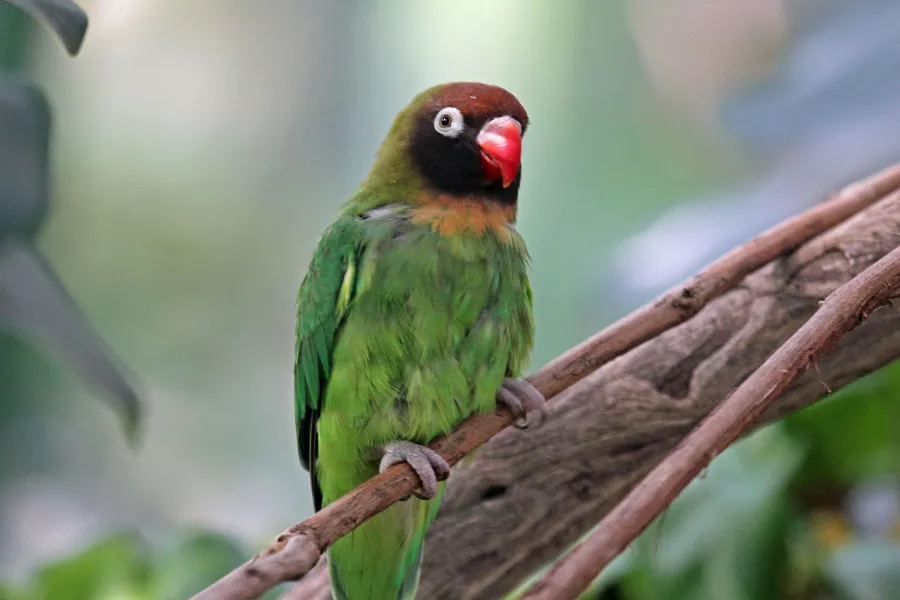What is black headed caique?
Black headed Keck parrot (scientific name: Pionites melanocephalus) 2 subspecies. It is a typical climbing bird, with anti-toed feet, two toes forward and two toes backward, suitable for grasping, strong and powerful beak, and can eat hard-shelled fruits. The plumage is brightly colored, and the male and female birds are very similar in appearance. The forehead and back of the neck are covered in a black hat, the cheeks, neck and cheeks are orange-yellow, the wings are green, and the chest and abdomen are white. Inhabits forests, palm groves, open plains, woodlands, and farming areas. Usually in pairs or small groups, the main food is fruits, berries, seeds, nuts, flowers and plant sprouts. Distributed in Brazil, Colombia, Ecuador, Peru and Venezuela and other countries.
What does a black headed caique look like?
There are only 2 subspecies of the black-headed Keck parrot. Body length 23 cm, weight 130-170 grams. Crown, neck, back pillow and upper part of cheeks are orange. The throat and sides of the head are yellow. The upper body, including the wings, is bright green. The chest and abdomen are creamy white. Flanks and thighs are green, while rump and undertail coverts are bright yellow. Wing axils are orange-red, contrasting with the rest of the underside of the wings being green. The tip of the tail is green. The beak is light pink, the skin around the eyes is pink, the iris is orange-red, and the legs are pink.
The Andean subspecies has yellow throat, flanks, and legs, pale yellow or white chest and belly, orange-yellow cheeks, and pale neck and midsection.
black headed caique living habits
Outside the breeding season, it often gathers in pairs or small groups. It is a common bird in the local area. It lives in groups, usually in pairs or gathering about 10 birds to forage on trees, and sometimes gathers more than 30 birds. Noisy and easy to observe birds. Often heard moving from one part of the forest to another, the sound of the wings flapping loudly, they usually stay at the top of the treetops, the slightest movement will occasionally scream. Mainly eat seeds, but also eat vegetables, fruits, nuts and other foods.
black headed caique rearing
The breeding season varies from place to place, around April-May in Colombia, around April in Venezuela, around December-February in Guyana, and around October-November in Suriname, usually laying three eggs at a time; caged black-headed Kecks are occasionally noisy, especially It is morning and evening, and you can quickly adapt to the new environment. The average lifespan is 25 to 34 years.
It is almost impossible to distinguish the sex of wild black-headed Keck parrots on the outside. You need to pay more attention when purchasing. It may be more helpful to choose two pairs of adult birds to be kept separately (in the case of adjacent cages). The infection that breeds first stimulates the desire and behavior of reproduction; it is quite aggressive during the breeding period, and the owner must pay attention when observing the nest box, so as not to frighten the parent bird or be bitten, about 3 eggs are laid at a time, and the incubation period is 26 days. Birds are mostly feathered at around 55 days, and at 60-70 days begin to move independently from the nest box, but it is dangerous. Feeding is mainly based on seed feed, vegetables, fruits, nuts, etc. All kinds of food are also recommended to be fed frequently.
Black-headed Keck parrots in captivity are occasionally noisy, especially in the morning and evening. They can quickly adapt to the new environment and become robust after adapting to the environment. The price of black-headed Keck parrots is comparable to that of golden-headed Keck parrots. It is much cheaper, but there are also many wild birds on the market. The artificially bred birds are large in size, look round and plump in appearance and are quite pleasing, with snow-white abdomens. Wild birds are small in size, afraid of people, and have poor plumage. Not very white, mixed with a dark color or grayish brown, it seems a little dirty. (It is recommended not to buy wild birds, one is to protect the wild population, and the other is not suitable for feeding) Most of them were quite shy and afraid of people when they were first introduced and should be provided all year round. Nest boxes, because they sleep in their nests more at night, hand-raised birds are cute and lovable, and are quite popular bird species.
Reminder: For more knowledge about angora rabbit, lemur, bearded reedling, golden hamster, red eyed tree frog, please pay attention to: mtedr.com, providing you with different types of small pets and pet care.


























